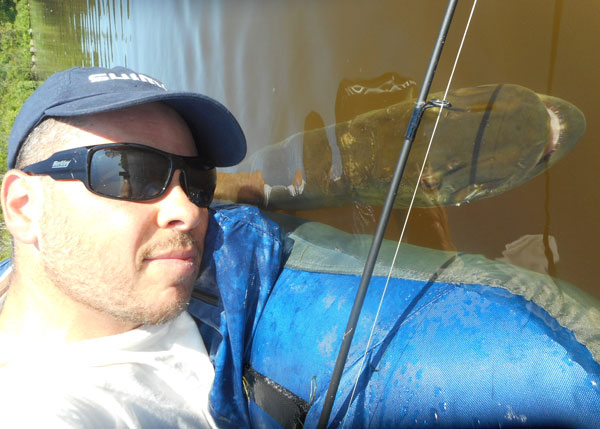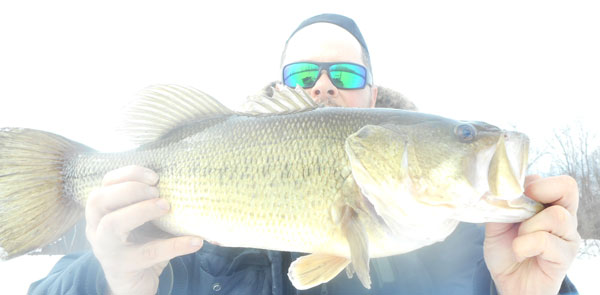Shortly after hitting the age of 40, I decided to get back into shape, as my weight had ballooned to close to 200 lbs. Standing under five and a half feet tall, my plan was to knock off 45 to 50 lbs, which I managed to do within a matter of about 12 months or so. Proper diet, eating habits and exercise were all part of my fitness plan.
5 years later, my weight cut has been maintained. I've tweaked my nutrition and workout routines over the years, as diets and fitness plans tend to get stagnant after a while. While a good mix of circuit training and cycling make up much of what I do to keep in shape, I've also learned to combine exercise with much of the solo fishing outing I do. Between saving time, gas, and combining to of my passions, it's turned out to be a win / win situation. At worst, I enjoyed a decent workout, and any fish I catch are a bonus.
General speaking, the primary fitness requirements for an active fishing lifestyle are:
1) Good cardio. Can't stress the importance of this one.
2) Mobility / flexibility. Regular stretching will keep you from getting sore.
3) Balance / agility. Being able to climb or scale a steep bank, wading in current, or running for a rod.
4) General conditioning. Upper body, core strength and legs.
Now, the question: What sort of exercise routines can you combine with sport fishing? Well, here are a few of mine, and rest assured, they end up being more of a workout than most people do at a fitness class or gym.
1) Cycling instead of driving.
For years, I have been cycling to my fishing spots on a regular basis from May to October every season. Living in the Cote Des Neiges district of Montreal, I can choose to ride South for 20-25 minutes, or North for about the same amount of time. In both cases, I'll hit riverfront trails, and being on a bike, I'm able to both run and gun from spot to spot without having to worry about parking.
The ride provides a good cardio workout, and keep my legs in shape as well. I tend to pack light, a rod, reel, few lures and bike lock go into my back pack. If I'm fishing South of my place, I have to contend with climbing some of Mount Royal on my way there, and most of the mountain on my way home. A decent workout on it's own, there is also the many kilometers of bike trail running from spot to spot.
Once at a given spot, I work the waterfront on foot, mainly casting lures for bass, pike, walleye and maybe an occasional musky, if I get lucky enough. All active fishing, so I'm actually constantly moving even when off my bike.
Average bike outing last 3 to 4 hours depending on where I go, and how good the bite is.
2) Hiking.
Hiking and trekking from spot to spot can be quite workout as well, especially when the terrain is rough. Mud, swampland, overgrown fields and forest all pose their challenges, and depending on the target species, I can be carrying anything from a light back pack, to heavy gear, a few lbs of bait, landing mat, net, and folding chair when I'm targeting carp in harder to reach areas.
Average hiking and trekking session will yield 1 to 3 hours of exercise.
3) Wading.
Wading consists of walking in shallow water to cast, drift or fly fish a given waterway. Most of the wading I do is in smaller river, mainly in the Adirondacks, for various species of trout, with the occasional bass, perch or fallfish being caught at the same time.
Standing knee deep in strong current and be quite challenging at time, and requires excellent balance. Providing a constant isometric lower body workout while casting with your upper body, between getting from spot to spot, and navigating slippery rocks in freezing water, you really end up feeling one with the river, not to mention getting quite a workout.
Average wading session with yield 4-6 hours of exercise.
4) Float tube fishing.
Last season, I purchased a float tube, in order to be able to fish spots that have limited access on foot, and none from a boat. While fishing from a float tube is extremely relaxing, it's actually quite the workout when covering lot's of water, especially when the wind picks up.
Propulsion and navigation is achieved by wearing fins on my feet, and using a steady up kick motion to move around from spot to spot (in reverse). I can slow troll on my way to any given area, or choose a slower pace and work shorelines by casting. I wear waders when the water is cool, and on warmer days, I stick with bathing suit and t-shirt.
Average float tube outings are in the 3-5 hour range.
5) Ice fishing.
Out of all the fishing related exercise I do, ice fishing is by far the most intense. Again, one may wonder how the stereotypical sitting in an ice hut or shanty drinking beer can be considered exercise.
Well, for starters, I don't use any shelter. Next, I rarely drive out onto a given lake or river; most of my spots are reached by trekking on foot with a sled filled with ice fishing gear. As I'm wearing many layers of heavy clothing and giant ice fishing boots, I probably weigh a good 20 lbs more once fully dressed. Pulling the sled through various depths and consistency of snow cover can get quite challenging at time.
Once I'm ready to drill, I opt to drill all my hole by hand. As opposed to using a heavy gas powered auger, or lighter battery powered drill, I prefer to stick with my trusty 6 inch diameter Fin Bore hand auger. Not having to deal with heavy, finicky engines that require pull starting and produce heavy fumes, nor having to deal with batteries that tend to freeze up very quickly in sub zero temps, makes the entire ice fishing experience more natural and enjoyable to me.
Hand drilling is relatively easy early on in the winter, when the ice is less than 10 inches thick. I can easily pop a goot 25-30 holes if need be.
Once you get into mid February or March, each hole will take a good 50-60 turns to drill into 22-24 inches of solid ice. As you get past the halfway mark though each hole, the resistance increases with all the built up ice chips.
Drilling more than 20 holes in 2 feet of ice, can get quote tiring. Maintaining a good pace with proper drilling technique is crucial, as is controlling your breathing throughout the drilling. I find it helps to count the turns of the drill, so you keep a mental count of your progress as you go along, it seems to make quite the difference. At this depth, each hole drilling will yield about 4-5 minutes of activity, between shovelling, drilling, cleaning and setting or resetting the line.
Average ice fishing session with yield a solid 1.5 to 2.5 hours of exercise between trekking and piercing holes, depending on the number of holes pierced.
6) Motorless boating.
Though I rarely use manually powered boats to fish from, fishing from inflatables, paddleboats, canoes and kayaks can all provide good cardio workouts. Whether one decides to troll or cast, maintaining proper speed (especially in wind) for hours at a time will yield better, and more enjoyable results than using a rowing machine at the gym.
So there you have it folks. Next time someone paints a picture of the stereotypical fat, lazy, beer swelling fisherman, challenge them to give any or all of the above techniques a fair shot.











No comments:
Post a Comment